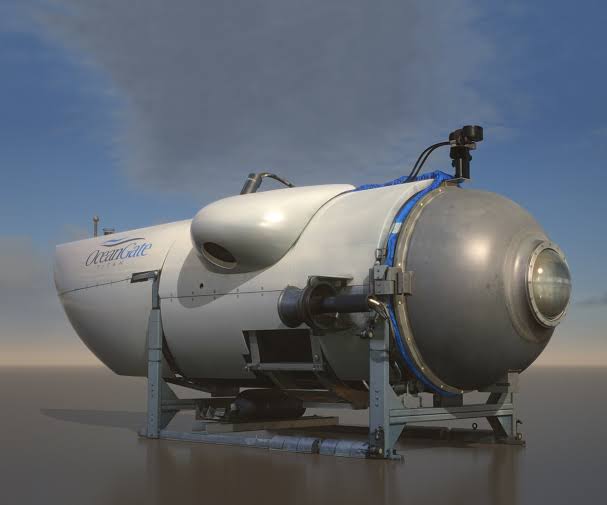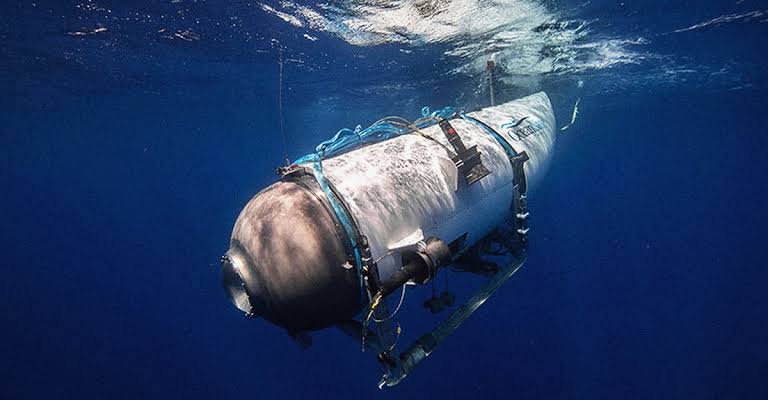The allure of exploring the depths of the ocean has always captivated adventurers and history enthusiasts alike. On June 18, 2023, an extraordinary underwater expedition took place as five individuals embarked on a journey to witness the remnants of the iconic Titanic. The submarine known as Titan descended into the depths of the sea, venturing approximately 3,810 meters below the surface.

However, what was meant to be a thrilling adventure turned into a tragic event as the submarine mysteriously vanished, leaving behind a trail of questions and speculation. In this article, we delve into the perplexing circumstances surrounding the disappearance of the Titan submarine and unravel the details of what actually transpired.
Who was present on the ship?

Aboard the vessel were five individuals: Rush, the founder of OceanGate; Hamish Harding, a billionaire British adventurer; Paul-Henri Nargeolet, a French maritime expert; Shahzada Dawood, a British Pakistani businessman; and his 19-year-old son Suleman, who accompanied him on the journey. Azmeh, Dawood’s sister, informed NBC News that her nephew had joined the expedition.
The Expensive Quest for Titanic’s Wreck:
The Titanic, a renowned historical ship that sank a century ago, holds a deep fascination for many. The opportunity to witness its wreckage firsthand through adventure tourism comes at a steep price. Each individual aboard the Titan submarine had invested over ₹20 million for a few hours of this exclusive tour.
The exorbitant cost is attributed to the fact that the wreckage lies hidden in the depths of the sea, specifically 3,810 meters beneath the water’s surface. The journey to reach this depth takes approximately two hours.
The Communication Channel:
The Titan submarine’s connection to the outside world was maintained through a communication channel with the support ship called the Polar Prince. Every 15 minutes, the submarine would send a signal to the support ship, ensuring a lifeline between the deep sea and the surface. On June 18, just one hour and 45 minutes into the dive, the submarine suddenly lost contact with the support ship. As the scheduled return time of 4:30 pm passed without any sign of the submarine, concern grew, and the team aboard the Polar Prince decided to alert the US Coast Guard. Thus began a multinational search operation that lasted four days.
The Extensive Search and Rescue Efforts:
The disappearance of the Titan submarine triggered a large-scale search and rescue operation involving aircraft, ships, and remotely operated vehicles (ROVs). The primary question on everyone’s minds was the fate of the passengers. The US Coast Guard reported that debris from the Titan had been retrieved from the ocean floor, indicating a catastrophic loss of the pressure chamber.
The multinational search operation was fraught with challenges due to the vast search area spanning 25,000 square kilometers, roughly seven times the size of Goa. However, despite the difficulties, the rescue teams were committed to finding the missing submarine.
The Titan Submersible:
To understand the circumstances surrounding the Titan’s disappearance, it is important to grasp the nature of the submersible itself. While often referred to as a submarine, the Titan was technically a submersible. Submarines possess their own power and can operate independently, while submersibles require a support ship present on the surface of the water. In this case, the Polar Prince served as the support ship for the Titan’s expedition.
The entire operation was conducted by OceanGate, a private company founded by Stockton Rush, an aerospace engineer turned CEO. OceanGate specialized in deep-sea expeditions and provided wealthy individuals with the opportunity to explore underwater wrecks and areas of interest.
Design and Features of the Titan Submersible:
The Titan submersible was specifically designed to reach a depth of 4,000 meters, making it the ideal vessel for exploring the Titanic wreckage. With a length of approximately 6.7 meters and a weight exceeding 10,400 kilograms, the Titan had a carbon fiber hull and titanium caps. Its viewport, or the largest window ever installed in a private submersible, allowed occupants to observe their surroundings. Interestingly, the submersible was controlled using a video game controller, a method.
The Legacy of the Titan Submarine
The disappearance of the Titan submarine has had a lasting impact on the world of underwater exploration. It has raised awareness of the risks involved in deep-sea diving, and it has led to calls for stricter regulations and guidelines for underwater tourism.
The Titan submarine is also a reminder of the human desire to explore the unknown. The five people who were on board the submarine were all experienced divers and scientists, and they were eager to explore the wreckage of the Titanic. Their disappearance is a tragedy, but it is also a testament to their courage and determination.
The mystery of the Titan submarine is likely to remain unsolved for many years to come. However, the legacy of the submarine will live on. It will serve as a reminder of the risks involved in deep-sea exploration, and it will inspire others to continue exploring the world’s oceans.
What mistakes did OceanGate make?
There are a few mistakes that OceanGate may have made that contributed to the disappearance of the Titan submarine.
First, the submarine was not equipped with a backup communication system. This meant that if the primary communication system failed, there would be no way for the submarine to contact the support ship.
Second, the submarine was not equipped with a fail-safe system that would have automatically brought it to the surface if it began to experience problems. This means that if there was a problem with the submarine, it could have continued to descend until it reached a depth where it imploded.
Finally, OceanGate may have not done enough to train the crew of the Titan submarine. The crew members were all experienced divers, but they may not have been adequately trained on how to operate the submarine in the event of an emergency.
It is important to note that these are just some of the mistakes that OceanGate may have made. The full investigation into the disappearance of the Titan submarine is still ongoing, and it is possible that other factors contributed to the accident.
Could this tragic incident have been prevented?
As rescuers worked diligently to locate the Titan, revelations surfaced indicating that the expedition itself had questionable origins. In 2018, OceanGate filed a lawsuit against a former employee named David Lochridge, who had been working on a report highlighting the risks associated with the construction of the Titan prior to his termination.
Lochridge was not alone in his concerns regarding the “experimental design” of the Titan. During the same year, a group of approximately 40 marine exploration leaders, explorers, and oceanographers penned a letter to OceanGate, outlining their apprehensions about the company’s safety testing.
They cautioned that sending the vessel to the Titanic could result in “negative outcomes ranging from minor to catastrophic.” Central to their worries was the fact that Rush, the founder of the company and the individual piloting the ill-fated voyage, allegedly refused to subject the Titan to inspection by an accredited agency.
The Marine Technology Society, the organization behind the letter, accused Rush of disseminating “misleading” information about the expedition by asserting that it adhered to the safety standards of a specific risk-assessment company, which had no intention of inspecting or certifying the vessel.
In the midst of these developments, a video featuring CBS reporter David Pogue touring the Titan gained traction online. In the video, Rush revealed that the entire vessel was operated using a $30 Logitech game controller, sparking concerns.
Pogue also shared other alarming details about the vessel, which he had previously visited in 2022 to witness the Titanic wreckage. During his visit, the Titan had become temporarily lost while on the surface, although it maintained communication at the time.
Another distressing piece of information Pogue disclosed via the BBC was that the Titan sealed shut from the outside, implying that even if it had managed to resurface without imploding, the passengers would have suffocated unless a team of experts were present to remove the bolts. Following the news of the passengers being presumed deceased, Pogue remarked, “It is difficult to fathom their sudden departure.”
Drawing parallels, James Cameron, who has made 33 submersible dives to the Titanic wreckage, highlighted similarities between the Titan and the original Titanic. He recalled how “the captain was repeatedly warned about ice ahead of his ship.” Cameron referred to this tragedy as a “very similar” one, where warnings were ignored. Meanwhile, Guillermo Sohnlein, one of OceanGate’s co-founders who departed from the company in 2013, urged the public to refrain from speculation until more data became available.
OceanGate has not publicly addressed any potential safety concerns regarding the Titan. Instead, the company’s statement paid tribute to the passengers as “true explorers who shared a distinct spirit of adventure and a deep passion for exploring and protecting the world’s oceans.” The statement further expressed grief over the loss of life and the joy the passengers brought to those who knew them.
The future of underwater adventure tourism
The disappearance of the Titan submarine has raised questions about the future of underwater adventure tourism. Some people believe that the accident will lead to stricter regulations and guidelines for underwater tourism, while others believe that the accident will deter people from participating in underwater activities.
It is still too early to say what the long-term impact of the Titan submarine disappearance will be on underwater adventure tourism. However, it is clear that the accident has raised awareness of the risks involved in deep-sea exploration. This may lead to more people taking precautions before participating in underwater activities, and it may also lead to the development of new safety measures and technologies.
Conclusion:
The disappearance of the Titan submarine during its expedition to explore the wreckage of the Titanic remains shrouded in mystery. Despite extensive search and rescue efforts, the fate of the five individuals aboard the submarine remains unknown.
The loss of contact between the submarine and the support ship, Polar Prince, triggered a multinational search operation that lasted for several days. Debris from the submarine was discovered on the ocean floor, indicating a catastrophic event, possibly involving the pressure chamber.
The Titan submersible, designed and operated by OceanGate, was a state-of-the-art vessel capable of reaching great depths. It provided wealthy individuals with the opportunity to explore underwater wrecks and other points of interest.
However, the circumstances leading to the disappearance of the Titan remain unclear, and further investigations and analysis will be necessary to uncover the truth.
The tragic incident serves as a reminder of the inherent risks involved in deep-sea exploration and the importance of safety measures and contingency plans. It also raises questions about the future of underwater adventure tourism and the need for stricter regulations and guidelines to ensure the well-being of participants.
As time passes, the mystery of the Titan submarine’s disappearance may be solved through technological advancements, new information, or unexpected discoveries. Until then, it stands as a sobering reminder of the unfathomable depths and the enduring mysteries that lie beneath the surface of our oceans.
